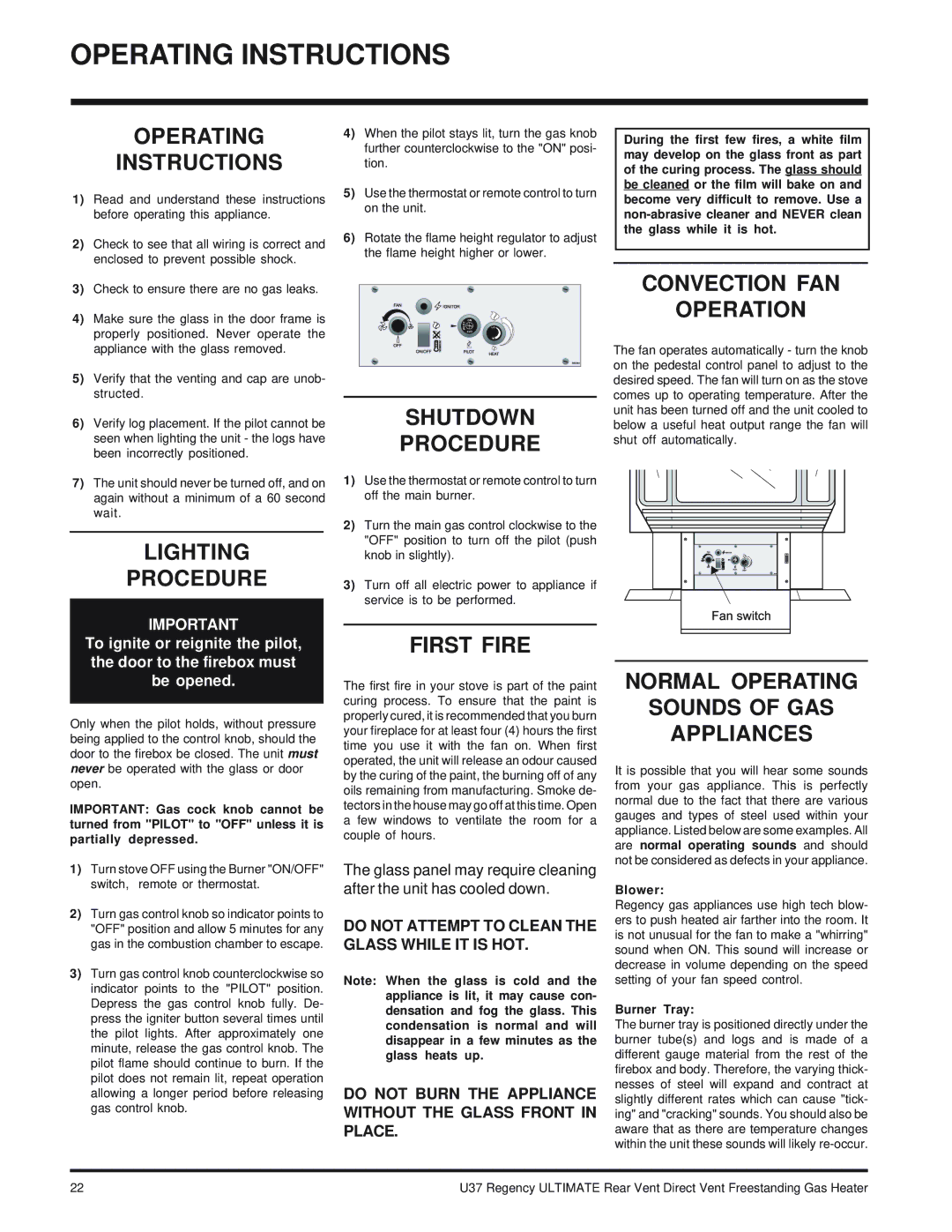
OPERATING INSTRUCTIONS
OPERATING
INSTRUCTIONS
1) | Read and understand these instructions |
| before operating this appliance. |
2) | Check to see that all wiring is correct and |
| enclosed to prevent possible shock. |
4)When the pilot stays lit, turn the gas knob further counterclockwise to the "ON" posi- tion.
5)Use the thermostat or remote control to turn on the unit.
6)Rotate the flame height regulator to adjust the flame height higher or lower.
During the first few fires, a white film may develop on the glass front as part of the curing process. The glass should be cleaned or the film will bake on and become very difficult to remove. Use a
3) | Check to ensure there are no gas leaks. |
4) | Make sure the glass in the door frame is |
| properly positioned. Never operate the |
| appliance with the glass removed. |
5) | Verify that the venting and cap are unob- |
| structed. |
6) | Verify log placement. If the pilot cannot be |
| seen when lighting the unit - the logs have |
| been incorrectly positioned. |
7) | The unit should never be turned off, and on |
| again without a minimum of a 60 second |
| wait. |
LIGHTING
PROCEDURE
IMPORTANT
SHUTDOWN
PROCEDURE
1)Use the thermostat or remote control to turn off the main burner.
2)Turn the main gas control clockwise to the "OFF" position to turn off the pilot (push knob in slightly).
3)Turn off all electric power to appliance if service is to be performed.
CONVECTION FAN
OPERATION
The fan operates automatically - turn the knob on the pedestal control panel to adjust to the desired speed. The fan will turn on as the stove comes up to operating temperature. After the unit has been turned off and the unit cooled to below a useful heat output range the fan will shut off automatically.
To ignite or reignite the pilot, the door to the firebox must be opened.
Only when the pilot holds, without pressure being applied to the control knob, should the door to the firebox be closed. The unit must never be operated with the glass or door open.
IMPORTANT: Gas cock knob cannot be turned from "PILOT" to "OFF" unless it is partially depressed.
1)Turn stove OFF using the Burner "ON/OFF" switch, remote or thermostat.
2)Turn gas control knob so indicator points to "OFF" position and allow 5 minutes for any gas in the combustion chamber to escape.
3)Turn gas control knob counterclockwise so indicator points to the "PILOT" position. Depress the gas control knob fully. De- press the igniter button several times until the pilot lights. After approximately one minute, release the gas control knob. The pilot flame should continue to burn. If the pilot does not remain lit, repeat operation allowing a longer period before releasing gas control knob.
FIRST FIRE
The first fire in your stove is part of the paint curing process. To ensure that the paint is properly cured, it is recommended that you burn your fireplace for at least four (4) hours the first time you use it with the fan on. When first operated, the unit will release an odour caused by the curing of the paint, the burning off of any oils remaining from manufacturing. Smoke de- tectors in the house may go off at this time. Open a few windows to ventilate the room for a couple of hours.
The glass panel may require cleaning after the unit has cooled down.
DO NOT ATTEMPT TO CLEAN THE GLASS WHILE IT IS HOT.
Note: When the glass is cold and the appliance is lit, it may cause con- densation and fog the glass. This condensation is normal and will disappear in a few minutes as the glass heats up.
DO NOT BURN THE APPLIANCE WITHOUT THE GLASS FRONT IN PLACE.
NORMAL OPERATING
SOUNDS OF GAS
APPLIANCES
It is possible that you will hear some sounds from your gas appliance. This is perfectly normal due to the fact that there are various gauges and types of steel used within your appliance. Listed below are some examples. All are normal operating sounds and should not be considered as defects in your appliance.
Blower:
Regency gas appliances use high tech blow- ers to push heated air farther into the room. It is not unusual for the fan to make a "whirring" sound when ON. This sound will increase or decrease in volume depending on the speed setting of your fan speed control.
Burner Tray:
The burner tray is positioned directly under the burner tube(s) and logs and is made of a different gauge material from the rest of the firebox and body. Therefore, the varying thick- nesses of steel will expand and contract at slightly different rates which can cause "tick- ing" and "cracking" sounds. You should also be aware that as there are temperature changes within the unit these sounds will likely
22 | U37 Regency ULTIMATE Rear Vent Direct Vent Freestanding Gas Heater |
